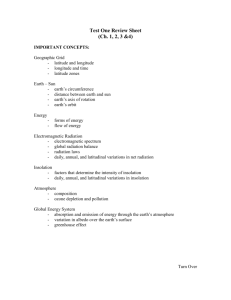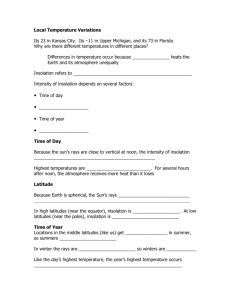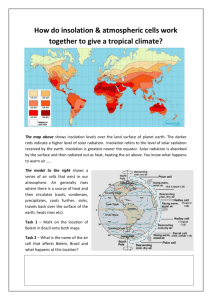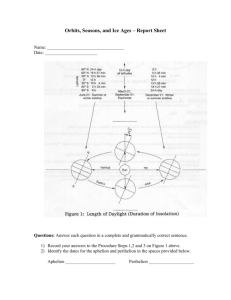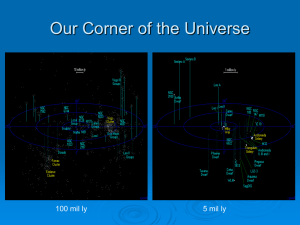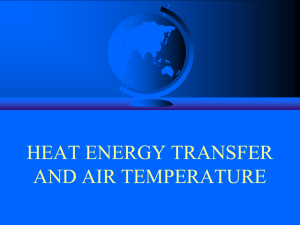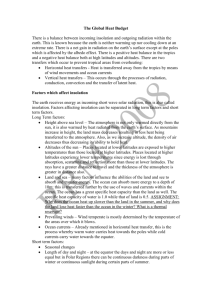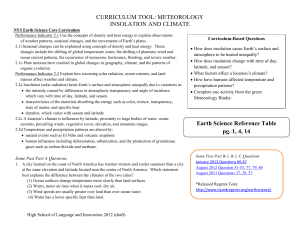Topic 6 Notes! - Cloudfront.net
advertisement
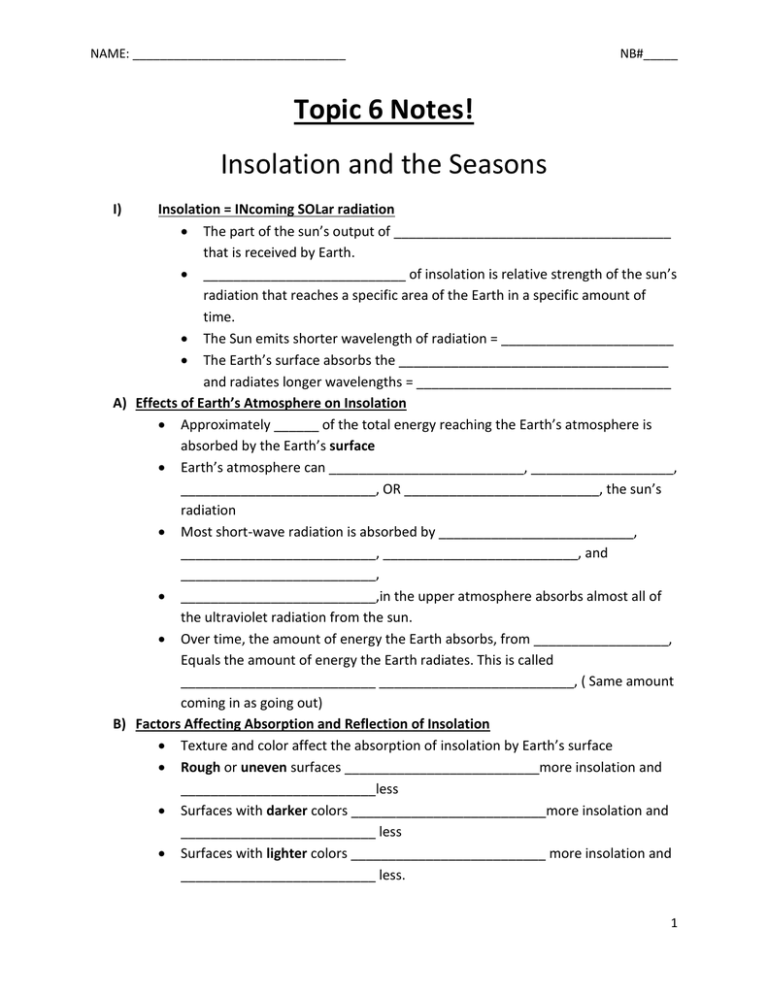
NAME: _______________________________ NB#_____ Topic 6 Notes! Insolation and the Seasons I) Insolation = INcoming SOLar radiation The part of the sun’s output of _____________________________________ that is received by Earth. ___________________________ of insolation is relative strength of the sun’s radiation that reaches a specific area of the Earth in a specific amount of time. The Sun emits shorter wavelength of radiation = _______________________ The Earth’s surface absorbs the ____________________________________ and radiates longer wavelengths = __________________________________ A) Effects of Earth’s Atmosphere on Insolation Approximately ______ of the total energy reaching the Earth’s atmosphere is absorbed by the Earth’s surface Earth’s atmosphere can __________________________, ___________________, __________________________, OR __________________________, the sun’s radiation Most short-wave radiation is absorbed by __________________________, __________________________, __________________________, and __________________________, __________________________,in the upper atmosphere absorbs almost all of the ultraviolet radiation from the sun. Over time, the amount of energy the Earth absorbs, from __________________, Equals the amount of energy the Earth radiates. This is called __________________________ __________________________, ( Same amount coming in as going out) B) Factors Affecting Absorption and Reflection of Insolation Texture and color affect the absorption of insolation by Earth’s surface Rough or uneven surfaces __________________________more insolation and __________________________less Surfaces with darker colors __________________________more insolation and __________________________ less Surfaces with lighter colors __________________________ more insolation and __________________________ less. 1 NAME: _______________________________ NB#_____ Water will heat up and cool off __________________________ than an equal area of land because water has a __________________________ specific heat QUESTIONS: Check Your Knowledge: 1. Electromagnetic energy that reaches Earth from the sun is called (1) Insolation (2) Conduction (3) Specific Heat (4) Terrestrial Radiation 2. How do the rates of warming and cooling of land surfaces compare to the rates of warming and cooling of ocean surfaces? (1) Land surfaces warm more quickly and cool more slowly (2) Land surfaces warm more slowly and cool more quickly (3) Land surfaces warm more quickly and cool more quickly (4) Land surfaces warm more slowly and cool more s lowly 3. Ozone is important to life on Earth because Ozone (1) Cools refrigerators and air conditioners (2) Absorbs energy that is radiated by Earth (3) Absorbs harmful ultraviolet radiation (4) Destroys excess atmospheric carbon dioxide. II) Variation in Intensity & Duration of Insolation The intensity of insolation varies because the angle at which the insolation strikes the Earth’s surface changes The maximum intensity occurs when the insolation strikes the surface __________________________ or at __________________________ 2 NAME: _______________________________ NB#_____ A) Earth’s Shape Since the Earth’s shape is an OBLATE SPHERIOD, at any one time, there is only on place where the insolation is direct (90 ⁰) B) Latitude and Seasonal Changes As the Earth travels in its yearly orbit around the ___________________________, the angle of incidence at any given ___________________________ varies with the seasons. This is because of the __________________________ of the Earth on its axis _________________________________ __________________________________ 3 NAME: _______________________________ Date Name of Date Latitude Receiving Direct Rays NB#_____ Name of Latitude #Hours of Daylight # Hours of Darkness March 21st June 21st September 21st December 21st C) Effect of Time of Day The duration of insolation also changes with the seasons and latitude. The duration of insolation also changes with seasons and latitude c) Effect of the Time of Day ______________________ noon is the time of day when the sun reaches its maximum altitude At the maximum altitude, the intensity is the __________________________ , and the shadows are the _____________________________. 4 NAME: _______________________________ NB#_____ QUESTIONS: Check Your Knowledge: 5 NAME: _______________________________ III) NB#_____ Reasons for the Season A) Tilt of the Earth’s Axis The Earth’s rotational axis is titled ____________________ from perpendicular to the plane of its orbit of the sun This tilt causes the _______________________________ rays of the sun to shift between ______________________________________________________________ and ______________________________________________________________ B) Parallelism of Earth’s Axis The North end of the Earth’s axis always points towards _________________________ C) Revolution of the Earth Around the Sun Because of _______________________________________, the direction of the Earth’s axis varies On ___________________________________________ The Northern hemisphere is tilted TOWARD the sun. The direct rays of the sun are striking _____________________. It is the __________________________________________ . On ___________________________________________ the Northern hemisphere is titled AWAY FROM the sun. The direct rays of the sun are striking ___________________________. It is the _______________________________. On _______________________ and _________________________ the Northern hemisphere is titled neither toward nor away from the sun. The direct rays of the sun are striking ____________________________________. It is the ____________________. QUESTIONS: Check Your Knowledge: 1. What is the primary reason New York State is warmer in May than in February (1) (2) (3) (4) Earth is traveling faster in its orbit in February The altitude of the noon sun is great in February The insolation in New York is greater in May Earth is closer to the sun in May 6
